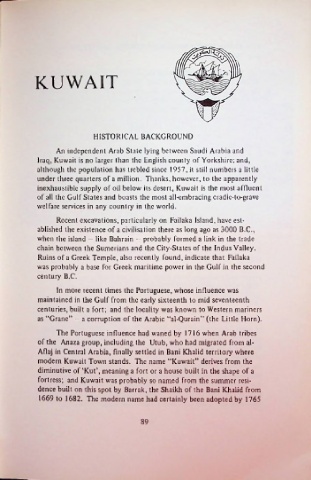Page 90 - The Postal Agencies in Eastern Arabia
P. 90
KUWAIT
HISTORICAL BACKGROUND
Ail independent Arab State lying between Saudi Arabia and
Iraq, Kuwait is no larger than the English county of Yorkshire; and,
although the population has trebled since 1957, it still numbers a little
under three quarters of a million. Thanks, however, to the apparently
inexhaustible supply of oil below its desert, Kuwait is the most affluent
of all the Gulf States and boasts the most all-embracing cradlc-to-grave
welfare services in any country in the world.
Recent excavations, particularly on Failaka Island, have est
ablished the existence of a civilisation there as long ago as 3000 B.C.,
when the island - like Bahrain - probably formed a link in the trade
chain between the Sumerians and the City-States of the Indus Valley.
Ruins of a Greek Temple, also recently found, indicate that Failaka
was probably a base for Greek maritime power in the Gulf in the second
century B.C.
In more recent times the Portuguese, whose influence was
maintained in the Gulf from the early sixteenth to mid seventeenth
centuries, built a fort; and the locality was known to Western mariners
as “Grane” - a corruption of the Arabic “al-Qurain” (the Little Horn).
The Portuguese influence had waned by 1716 when Arab tribes
of the Anaza group, including the Utub, who had migrated from al-
Aflaj in Central Arabia, finally settled in Bani Khalid territory where
modern Kuwait Town stands. The name “Kuwait” derives from the
diminutive of ‘Kut\ meaning a fort or a house built in the shape of a
fortress; and Kuwait was probably so named from the summer resi
dence built on this spot by Barrak, the Shaikh of the Bani Khalid from
1669 to 1682. The modern name had certainly been adopted by 1765
89

